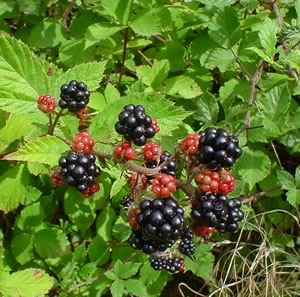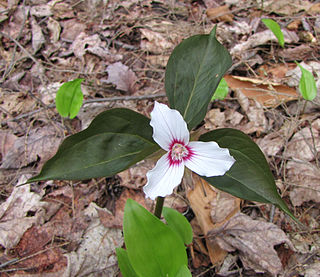
Rubus is a large and diverse genus of flowering plants in the rose family, Rosaceae, subfamily Rosoideae, with over 1,350 species.

The raspberry is the edible fruit of a multitude of plant species in the genus Rubus of the rose family, most of which are in the subgenus Idaeobatus. The name also applies to these plants themselves. Raspberries are perennial with woody stems. World production of raspberries in 2020 was 895,771 tonnes, led by Russia with 20% of the total.

Rubus idaeus is a red-fruited species of Rubus native to Europe and northern Asia and commonly cultivated in other temperate regions.

Rubus caesius is a Eurasian species of dewberry, known as the European dewberry. Like other dewberries, it is a species of flowering plant in the rose family, related to the blackberry and raspberry. It is widely distributed across much of Europe and Asia from Ireland and Portugal as far east as Xinjiang Province in western China. It has also become sparingly naturalized in scattered locations in Argentina, Canada, and the United States.

Rubus occidentalis is a species of Rubus native to eastern North America. Its common name black raspberry is shared with other closely related species. Other names occasionally used include bear's eye blackberry, black cap, black cap raspberry, and scotch cap.

Rubus parviflorus, commonly called thimbleberry, is a species of Rubus native to northern temperate regions of North America. The plant has large hairy leaves and no thorns. It bears edible red fruit similar in appearance to a raspberry, but shorter, almost hemispherical. It has not been commercially developed for the retail berry market, but is cultivated for landscapes.

Rubus odoratus, the purple-flowered raspberry, flowering raspberry, or Virginia raspberry, is a species of Rubus, native to eastern North America, from Nova Scotia west to Ontario and Wisconsin, and south along the Appalachian Mountains as far as Georgia and Alabama.

Rubus leucodermis, also called whitebark raspberry or blackcap raspberry, is a species of Rubus native to western North America.

Rubus niveus is a species of Rubus native to southern Asia, from Afghanistan east through India and China to Taiwan and the Philippines, south to Sri Lanka and Malaysia, and north to Gansu in China.

Nuphar advena is a species of Nuphar native throughout the eastern United States and in some parts of Canada, such as Nova Scotia. It is similar to the Eurasian species N. lutea, and is treated as a subspecies of it by some botanists, though differing significantly in genetics.

Trillium undulatum, commonly called painted trillium, painted lady, or trille ondulé in French, is a species of flowering plant in the bunchflower family Melanthiaceae. It is also known as smiling wake robin or striped wake-robin. The specific epithet undulatum means "wavy", which refers to the wavy edges of the flower petals. The plant is found from Ontario in the north to northern Georgia in the south and from Michigan in the west to Nova Scotia in the east.

Rubus ursinus is a North American species of blackberry or dewberry, known by the common names California blackberry, California dewberry, Douglas berry, Pacific blackberry, Pacific dewberry and trailing blackberry.

Erigeron strigosus is a species of flowering plant in the family Asteraceae known by the common names prairie fleabane, common eastern fleabane, and daisy fleabane.

Rubus parvifolius, called Japanese bramble, or Australian raspberry in the United States or native raspberry in Australia is a species of plant in the rose family. It is a scrambling shrub native to eastern Asia and Australia. It has also become naturalized in a few scattered locations in the United States.
Rubus aculifer, the thorny dewberry, is a rare North American species of flowering plant in the rose family.
Rubus adenocaulis is a rare North American species of flowering plant in the rose family. It has been found only in the Province of Nova Scotia in the eastern Canada.
Rubus tholiformis is a rare North American species of flowering plant in the rose family. It has been found only in eastern Canada and the northeastern United States.
Rubus adjacens, the peaty dewberry, is a rare North American species of flowering plant in the rose family. It is native to eastern Canada and the northeastern and east-central United States (Maine, New Hampshire, Vermont, Massachusetts, New York, Pennsylvania, Maryland.
Rubus arcuans, the wand dewberry, is a rare North American species of flowering plant in the rose family. It is found in eastern Canada the northeastern United States.
Rubus severus is an uncommon North American species of flowering plant in the rose family. It is found in eastern Canada and the northeastern and north-central United States.















